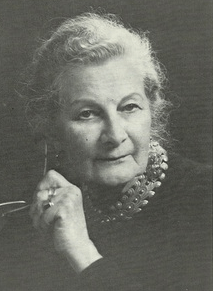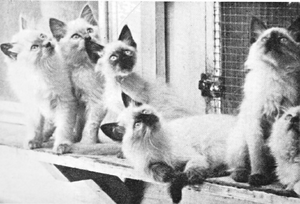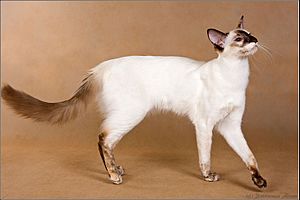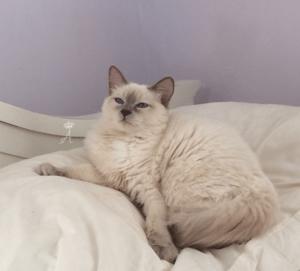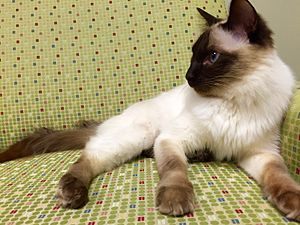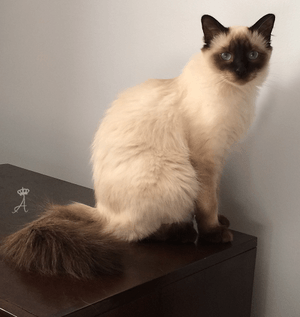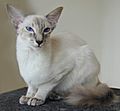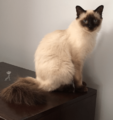Balinese cat facts for kids
Quick facts for kids Balinese cat |
|
|---|---|
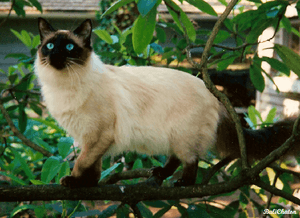
Old-style seal point Balinese
|
|
| Other names | Long-haired Siamese Thai Siamese |
| Origin | United States |
| Breed standards | |
| CFA | standard |
| FIFe | standard |
| TICA | standard |
| ACF | standard |
| ACFA/CAA | standard |
| CCA-AFC | standard |
| GCCF | standard |
| Domestic cat (Felis catus) | |
The Balinese is a beautiful breed of domestic cat. It looks a lot like a Siamese cat but has a medium-length, silky coat. Balinese cats have special point coloration, meaning their fur is darker on their face, ears, paws, and tail. They also have striking sapphire-blue eyes.
This breed is sometimes called the purebred long-haired Siamese. This is because it started as a natural change in Siamese cats. So, it's basically a Siamese cat with longer, flowing fur and a fluffy tail.
Just like Siamese cats, Balinese cats come in two main body types. There's the traditional or "old-style" Balinese. There's also the modern type, which is more slender. The Balinese breed got its name from the island of Bali. However, these cats do not actually come from Bali or Java.
Balinese cats are known for being very social and playful. They are also quite vocal and curious. They are considered a very smart breed, much like their Siamese relatives.
Contents
History of the Balinese Cat
The Balinese cat breed did not actually come from Bali or any part of Indonesia. Its story began in the mid-1800s. This is when the first Siamese cats were brought from Thailand to the United States and the United Kingdom. Some of these early Siamese cats carried a special gene for long hair.
Over time, some Siamese litters would have kittens with longer fur. At first, these long-haired kittens were seen as a "mistake" in the breed. They were usually sold only as pets. Records show these cats existed as early as the 1900s. In 1928, "Long-haired Siamese" cats were first officially registered for cat shows. This happened with the American Cat Fanciers' Federation.
Developing the Breed
In the mid-1950s, cat breeders in the United States started working hard. They wanted to make the long-haired Siamese a separate, recognized breed. One of the first breeders, Helen Smith, thought "Long-haired Siamese" was too long a name. She decided to call the new breed "Balinese." She chose this name because the cats moved with the same grace as Balinese dancers.
A breeder named Sylvia Holland helped to set the breed's standards. She was also an illustrator for Walt Disney Studios. She worked on this in the 1960s and 1970s. Sylvia Holland believed that only cats with classic Siamese colors were true Balinese. These colors included seal, chocolate, blue, and lilac points. She did not accept other colors, thinking they came from mixing with other breeds.
Meanwhile, the American Cat Fanciers' Association (CFA) made some changes. They classified Siamese cats with red, cream, lynx (tabby), and tortoiseshell patterns as a separate breed. This new breed was called the Colorpoint Shorthair. Later, the long-haired cats that came from these new colors were also classified separately. They were named "Javanese," continuing the Indonesian island theme.
Old-Style vs. Modern Balinese
Like their Siamese ancestors, Balinese cats slowly developed into two different types. These types were based on their physical appearance. The traditional Siamese, also called "old-style" or "apple-head," was popular when the Balinese breed began. These old-style Balinese cats still look very much like the first cats bred.
However, as the short-haired Siamese became more popular, a new trend started. Breeders began to prefer a more slender, long, and wedge-shaped head type. The modern Balinese cat was then developed from this newer Siamese look. By the mid-1980s, the old-style Balinese cats were rarely seen at cat shows. Only a few breeders kept the original Balinese type alive. Because of this, the two types of Balinese cats now have very few shared ancestors.
Balinese and Javanese Breeds
For a while, there was talk in the Cat Fanciers' Association about combining the Balinese and Javanese breeds. The Javanese is a mix between the Colorpoint Shorthair and the Balinese. In 2008, breeders decided to combine them. They declared the Javanese as a color group within the Balinese breed. The CFA was the only group that thought Javanese was a separate breed.
This change did not affect the colors or description of the Balinese. They are still two separate groups, but now they are both under the Balinese breed name. The Javanese still has its original colors, and the Balinese keeps its classic colors. This move helped the CFA match other cat registries around the world. It also aimed to increase Balinese registrations. This encourages more people to breed and show these beautiful cats.
What Balinese Cats Look Like
Appearance Details
The two types of Balinese cats look similar to their Siamese relatives. Both types are generally slender and graceful. They have fine bones, long legs, and long tails. Their paws are neat and oval-shaped. They have almond-shaped eyes and large, pointed ears.

However, there are some differences. The traditional type is a bit more solid. It has a broader head and a sturdier body. The modern type has a more noticeable wedge-shaped head. Its muzzle is long and tapers, and its ears are longer and wider. Its body is also more slender and elongated.
Coat and Color of Balinese Cats
The Balinese cat's coat is usually medium-length. The length can vary a lot from one cat to another. The fur should be soft and silky. It does not have the fluffy undercoat that many other long-haired breeds have. Kittens born from two Balinese parents will have longer fur than those from a Balinese and a Siamese. All Balinese cats should have a distinct plume, or fringe, of longer hair on their tail.
Their eye color can range from pale blue to sapphire or violet. The intensity of the color might change a little with age or diet. You can tell a kitten's color point by looking at its paw pads. Chocolate and lilac points have pink pads. Blue and seal points have dark pads.
Like all cats with the point pattern, Balinese kittens are born pure cream or white. Their darker points slowly appear in the colder parts of their body. These areas include their face, ears, paws, and tail. Their true color is usually clear by the time they are four weeks old. Some cats get darker as they get older. Also, adult Balinese cats living in warm places often have lighter coats than those in cool climates.
Most cat associations around the world accept Balinese cats in many colors. These include seal, blue, chocolate, lilac, red, and cream points. They also accept tortoiseshell and lynx point patterns in all these colors. However, the Cat Fanciers' Association (CFA) still only accepts Balinese cats in the classic seal, blue, chocolate, and lilac points. All other possible colors and patterns are classified separately as Javanese.
Balinese Cat Personality
Temperament and Behavior
Balinese cats share many traits with their short-haired Siamese relatives. They are very social and playful cats. They are intensely interested in everything happening around them. Balinese cats tend to "talk" often and loudly, though usually at a lower volume than a Siamese.
They are thought to be the smartest of all the long-haired cat breeds. Balinese cats are also known for being very agile and acrobatic. They often enjoy close contact and cuddles with their owners.
Allergy Claims
Many people say that Balinese cats cause fewer allergy problems than most other cat breeds. While there isn't a lot of scientific proof yet, studies have shown something interesting. Balinese cats produce very small amounts of the Fel d1 and Fel d4 proteins. These proteins are common allergens that cause reactions in people. Some Balinese breeders are working to get more scientific evidence about this "hypoallergenic" quality.
Balinese Cat Health
Balinese cats are generally considered a healthy breed. They tend to have only a few health problems. However, because they are a purebred cat, they come from a small group of cats. This means they might be more likely to inherit some health issues.
One possible confirmed disease for Balinese cats is Progressive retinal atrophy (PRA). This is a problem where the retina in the eye slowly breaks down. It can lead to poor vision or even blindness.
There have also been some cases of Balinese cats having dilated cardiomyopathy. This is a disease that makes the heart muscles larger, which can reduce how well the heart works. Some people also claim they have a low risk for hypertrophic cardiomyopathy (HCM), another heart condition.
Another potential health problem is liver amyloidosis. This is a condition where a certain protein builds up in organs, most often the liver. This can eventually lead to organ failure. Liver amyloidosis is known to occur in Siamese cats, and since the Balinese is a type of Siamese, it may inherit this issue.
Sometimes, Balinese cats can inherit a rare condition that makes their blue, almond-shaped eyes look crossed. This is called Strabismus, and it is common in Siamese cat breeds.
Images for kids
See also
 In Spanish: Gato balinés para niños
In Spanish: Gato balinés para niños


